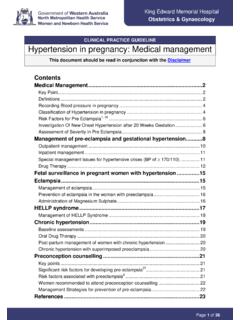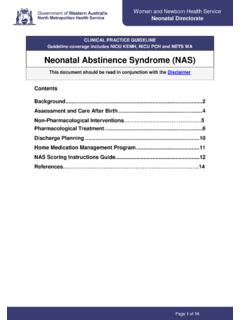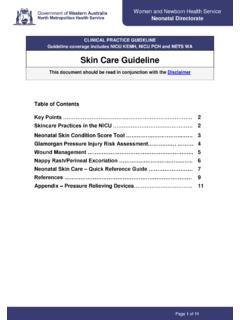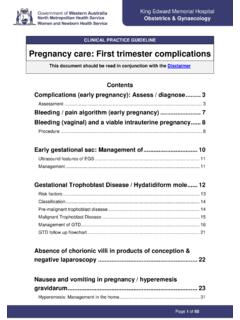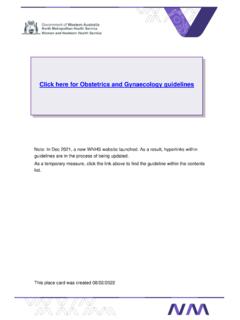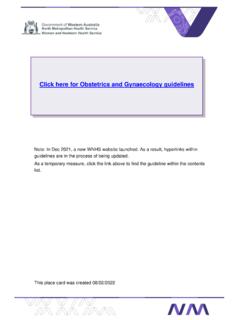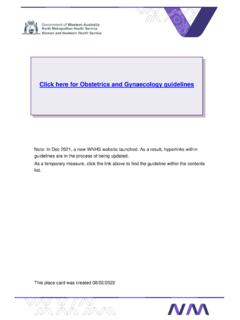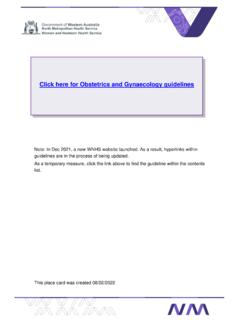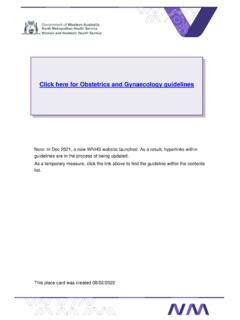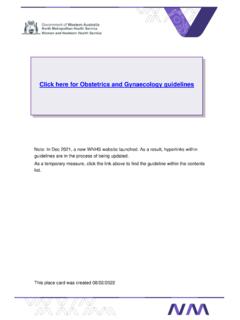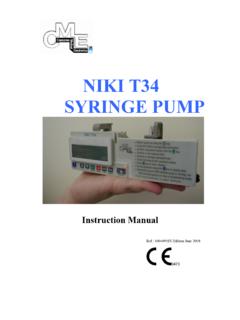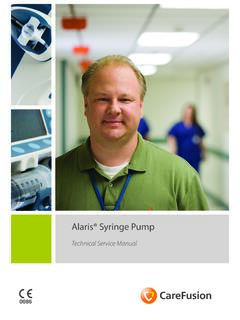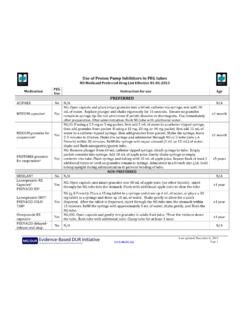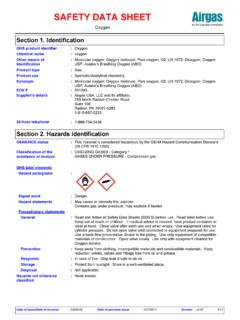Transcription of Niki t34 syringe pump: continuous subcutaneous infusion ...
1 Aim To guide staff in commencement and management of the NIKI T 34 syringe pump. Key points 1. Prior to looking after a patient with this pump, all staff must have received instruction on how to operate the pump. 2. Advise the patient that the pump must not get wet. A protective plastic bag should be used in the shower. Background The Niki pump is a system that delivers a continuous infusion of medications via the subcutaneous route, for symptom control. This is a very useful alternative when the oral route is not possible or practical when the patient is unable to swallow safely, has intractable vomiting, intestinal obstruction or is unable to absorb oral medications for any reason. It is most frequently used in palliative care settings and persistent pain syndromes. Components The system consists of: 1. A subcutaneous catheter (Saf T Intima) which is placed in the subcutaneous tissue and held in place by a clear dressing.
2 A clear dressing is preferred because it allows easy inspection of the insertion site. 2. The cannula is connected to the Niki pump via a variable length of sterile tubing. 3. The Niki pump is a small portable machine which drives a syringe . It is OBSTETRICS AND GYNAECOLOGY CLINICAL PRACTICE GUIDELINE Niki t34 syringe pump: continuous subcutaneous infusion management Scope (Staff): WNHS Obstetrics and Gynaecology Directorate staff Scope (Area): Obstetrics and Gynaecology Directorate clinical areas at KEMH This document should be read in conjunction with this Disclaimer Niki t34 syringe pump: continuous subcutaneous infusion management Page 2 of 10 Gynaecology powered by a 9 volt battery. The pump itself is enclosed in sturdy plastic container which can be locked and is tamper proof. 4. A syringe which can contain a variety of medications that is needed for symptom control.
3 This can be adjusted as necessary for optimum symptom control. The pump pushes the plunger of the syringe steadily over 24 hours so that a consistent dose of medication is delivered continuously and a steady blood level of medications is maintained. Advantages of the Niki system 1. Consistent 24 hour delivery of medications ensuring constant optimal blood levels and hence steady symptom control. 2. It can be used when medications cannot be taken orally. 3. It is easy to use and does not require venous access. 4. The cannula is to be changed every 7 days, reducing the need for repeated punctures to the skin and is therefore less traumatic for the patient. Disadvantages of the Niki system 1. As it involves puncturing the skin, infection can occur. However, the infections are generally superficial, uncommon and easy to diagnose and manage. 2. It involves use of a small machine that needs to be carried by the ambulant patient.
4 It is not water proof and needs to be covered by a plastic bag when showering. 3. Only some medications can be delivered by the subcutaneous route (Please refer to Palliative Care Consultant). 4. With the initial set up and with any change of medications, it will take about 3 hours for the blood levels to stabilise. It is therefore not useful for instant symptom control. Its main use is the delivery of medications to maintain background levels for symptom control similar to slow release formulations. 5. It does not have a bolus function for delivering rescue medications for control of break through symptoms. Placement of the subcutaneous needle Consider mobility, comfort and ease of access. Ambulatory patients- consider the abdomen or chest Agitated or distressed patients- the scapula is the preferred site If in doubt, please contact the Palliative Care Consultant Niki t34 syringe pump: continuous subcutaneous infusion management Page 3 of 10 Gynaecology Sites not suitable for subcutaneous catheter placement Acknowledgement: SCGHOPHCG: Insertion of subcutaneous catheter within SCGH/OPH NPG 32 subcutaneous Infusions ( syringe Drivers) and subcutaneous Fluid Administration guideline.
5 Equipment Documentation: subcutaneous infusion Chart: Prescription and Progress Record Chart ( ) with documented prescription by doctor NIKI T34 syringe pump, rigid locked box and carry pouch subcutaneous Niki T34 syringe Driver SAF-T-Intima catheter. Saf-T-Intima catheters are used to reduce local site reactions and therefore increase longevity and reduce needle stick injuries. 70% isopropyl alcohol 2% chlorhexidine cleansing swab subcutaneous drug additive labels Gloves (non-sterile) and PPE as required Needleless cap (bung) Prescribed medication, diluent and drawing-up needles / syringes A valid prescription must be written on MR ( continuous subcutaneous infusion : Prescription & Progress Record Chart) 20mL Luer Lock syringe (occasionally a 30mL may be required) Luer lock extension tubing min. 75cm to max. 100cm in length 10cm x 10cm sterile transparent dressing ( tegaderm, opsite) 9 volt battery (ensure a spare battery is available on the ward).
6 Always use an alkaline battery. Do not use non-alkaline or rechargeable batteries. Site Reasons why not suitable Skin folds Device cannot be safely secured infusion site not easily observed Potential for impaired absorption Limb oedema / Lymphedema Infection risk Impaired absorption Bony prominence Reduced subcutaneous tissue Impaired absorption Device cannot be safely secured Previously irradiated skin Impaired blood supply reduced absorption Infection risk Dry/delicate skin Near joints Potential for dislodgment Uncomfortable for patient Infected / broken skin Potential for infection (To be used on extension tubing) Niki t34 syringe pump: continuous subcutaneous infusion management Page 4 of 10 Gynaecology Procedure Note: Attend the 5 moments of hand hygiene throughout the procedures as required. Day 1- Commencement of infusion Ensure the NIKI T34 has been pre-programmed to a fixed duration of 24 hours and has the programme lock function on.
7 Fitting the battery 1. Slide the compartment cover at the back of the pump. Place the battery into the compartment. 2. Ensure battery terminals are aligned as per the diagram inside the compartment. Battery test 1. Always check there is enough charge to set up the infusion (usually > 20%). 2. Switch the pump on (press and hold ON/OFF button until beeps ). 3. Press the INFO key. 4. Select BATTERY LIFE from the menu and press YES to confirm. 5. Verify that sufficient battery charge is available to complete the current programme. If not, change the battery. Then hold the ON/OFF button until beeps to turn off. syringe selection 1. The T34 is programmed to recognise most commonly used syringes from 2- 50mL Loading the syringe 1. Perform hand hygiene. 2. Draw up the prescribed medication and diluent to equal 18mL in total (ensure appropriate documentation of S4R/S8 medications).
8 3. Connect the extension line via needleless cap (bung) to the available Y connector of the SAF-T-Intima catheter. 4. Connect the extension line to the Luer Lock syringe . 5. Press and hold the ON/OFF button until it beeps to turn on. 6. The version of the software will flash on the screen. The screen will then flash Pre-loading . Wait for the pump to pre load. It calibrates itself during this process. 7. Measure the drawn up syringe against the NIKI T34 and press either FF or BACK to align actuator to the syringe plunger. The actuator can only be moved in this way. Do not try and force and move the actuator manually as this could damage the device. 8. The pump will state Load syringe . Niki t34 syringe pump: continuous subcutaneous infusion management Page 5 of 10 Gynaecology 9. Raise the barrel arm clamp and place the syringe in, then lower the barrel arm clamp.
9 If the syringe is not placed in correctly the screen will flash at which sensor the placement is incorrect. Check the 3 sensors: A - Barrel Clamp Arm B - syringe ear/collar sensor small metal switch. Detect the secure loading of the syringe collar. C - Plunger Sensor- ensure plunger between the fingers. 10. Once the syringe is correctly loaded, the screen will ask for identification of the syringe brand. Use the to select syringe brand. 11. Review and check the data on the screen- Volume, Duration, Rate , 24 hours, / hour. Recommended rate range ml/hr. 12. To confirm press YES 13. Display will read START infusion . DO NOT COMMENCE infusion IF THIS IS DAY 1 as the line requires priming, or if changing extension tubing and catheter. Priming the line 14. Do not manually prime the extension set, use the pump settings to do this. 15. Press the FF button. The display will read PURGE DISCONNECT FROM PATIENT.
10 Note: If priming fails to be completed correctly, remove the syringe , turn the pump off and recommence from step 1. 16. Confirm disconnection by pressing YES. 17. To prime the line, press and hold the FF button. Maximum purge is 2mL. The screen will display: press YES to resume, NO for new syringe . Press YES to resume, not NO for new syringe , otherwise pump will not have calculated for priming the line. A B C Niki t34 syringe pump: continuous subcutaneous infusion management Page 6 of 10 Gynaecology 18. Once primed, again select the correct brand of the syringe . 19. Press YES to resume. 20. The display will now show the new volume and a new duration. The rate will remain constant. 21. To confirm press YES . 22. Connect the infusion line to the patient. Commencing the infusion 1. Pump will state START infusion ? . To confirm press YES . 2. With the commencement of the pump the keypad lock needs to be activated.
